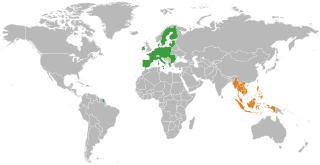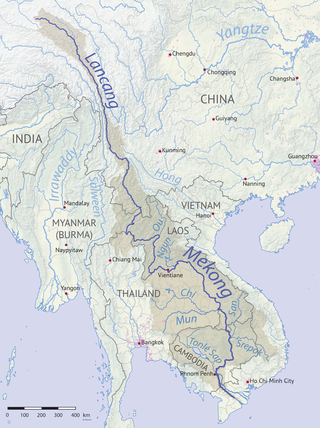
The Mekong or Mekong River is a transboundary river in East Asia and Southeast Asia. It is the world's twelfth-longest river and the third-longest in Asia with an estimated length of 4,909 km (3,050 mi) and a drainage area of 795,000 km2 (307,000 sq mi), discharging 475 km3 (114 cu mi) of water annually. From its headwaters in the Tibetan Plateau, the river runs through Southwest China, Myanmar, Laos, Thailand, Cambodia, and southern Vietnam. The extreme seasonal variations in flow and the presence of rapids and waterfalls in the Mekong make navigation difficult. Even so, the river is a major trade route between Tibet and Southeast Asia. The construction of hydroelectric dams along the Mekong in the 2000s through the 2020s has caused serious problems for the river's ecosystem, including the exacerbation of drought.

The Association of Southeast Asian Nations, commonly abbreviated as ASEAN, is a political and economic union of 10 states in Southeast Asia. Together, its member states represent a population of more than 600 million people and land area of over 4.5 million km2 (1.7 million sq mi). The bloc generated a purchasing power parity (PPP) gross domestic product (GDP) of around US$10.2 trillion in 2022, constituting approximately 6.5% of global GDP (PPP). ASEAN member states include some of the fastest growing economies in the world, and the institution plays an integral role in East Asian regionalism.

The Mekong River Commission (MRC) is an "...inter-governmental organisation that works directly with the governments of Cambodia, Laos, Thailand, and Vietnam to jointly manage the shared water resources and the sustainable development of the Mekong River". Its mission is "To promote and coordinate sustainable management and development of water and related resources for the countries' mutual benefit and the people's well-being".
Japan has been establishing its foreign aid contributors since the 1990s. The three government institutions involved in disbursing this are: the Japan International Cooperation Agency (JICA), and the Japanese Bank of International Cooperation (JBIC). This is now the nodal agency for all Japanese concessional loans, and replaced Japan Export-Import Bank (JEXIM) and the Overseas Economic Cooperation Fund (OECF) in 1999.

The Bay of Bengal Initiative for Multi-Sectoral Technical and Economic Cooperation (BIMSTEC) is an international organisation of seven South Asian and Southeast Asian nations, housing 1.73 billion people and having a combined gross domestic product of US$5.2 trillion (2023). The BIMSTEC member states – Bangladesh, Bhutan, India, Myanmar, Nepal, Sri Lanka, and Thailand – are among the countries dependent on the Bay of Bengal.
Ayeyawady-Chao Phraya-Mekong Economic Cooperation Strategy (ACMECS) is a political, economic, and cultural organization among Thailand, Laos, Vietnam, Cambodia and Myanmar. At the special ASEAN Summit on SARS, held in Bangkok on 29 April 2003, Prime Minister Thaksin Shinawatra raised the idea of establishing what was then called the “Economic Cooperation Strategy", with leaders of Cambodia, Lao PDR and Myanmar.

The Greater Mekong Subregion, (GMS) or just Greater Mekong, is a trans-national region of the Mekong River basin in Southeast Asia. The region is home to more than 300 million people. It came into being with the launch of a development program in 1992 by the Asian Development Bank that brought together the six Asian countries of Cambodia, China, Laos, Myanmar (Burma), Thailand, and Vietnam.

The Mekong–Ganga Cooperation (MGC) was established on November 10, 2000, at Vientiane, Laos at the First MGC Ministerial Meeting. It comprises six member countries, namely India, Thailand, Myanmar, Cambodia, Laos and Vietnam. The four areas of cooperation are tourism, culture, education, and transportation. The organization takes its name from the Ganga and the Mekong, two large rivers in the region.

The Act East policy is an effort by the Government of India to cultivate extensive economic and strategic relations with the nations of Southeast Asia to bolster its standing as a regional power and a counterweight to the strategic influence of the People's Republic of China.

The ASEAN–European Union relations are the bilateral foreign relations between the two organisations; the European Union (EU), and the Association of Southeast Asian Nations (ASEAN). EU and ASEAN have been interacting with each other on the economic, trade, and political levels for more than four decades. The partnership between the EU and ASEAN dates back to 1972, when the EU established ties with ASEAN. The EU became an ASEAN Dialogue Partner in 1977.

India–Thailand relations, also known as the Indo–Thai relations, are the bilateral relations between India and Thailand. Relations were established in 1947, soon after India gained independence. Priests have provided a cultural link between the two countries since 1500 BCE. India shares a long sea border with Thailand as India's Andaman and Nicobar Islands share a maritime border with Thailand along the Andaman Sea. Since 2001, both countries have witnessed growing warmth, increasing economic and commercial links, exchange of high-level visits, and the signing of various agreements leading to a further intensification of relations. Thailand and India are cooperating in various multilateral fora like India's dialogue partnership with ASEAN, the ASEAN Regional Forum (ARF), and the East Asia Summit, the sub-regional grouping BIMSTEC involving Bangladesh, India, Sri Lanka, Thailand, Myanmar, Nepal and Bhutan, and trilateral transport linkages with Thailand, Myanmar and India. India is a member of the Asia Cooperation Dialogue (ACD) initiated by Thailand in 2002 and of the Mekong–Ganga Cooperation (MGC), a group of six countries.
The ASEAN Summit is a biannual meeting held by the members of the Association of Southeast Asian Nations (ASEAN) in relation to economic, political, security, and socio-cultural development of Southeast Asian countries. The league of ASEAN is currently connected with other countries who aim to participate on the missions and visions of the league.
Energy use and development in Africa varies widely across the continent, with some African countries exporting energy to neighbors or the global market, while others lack even basic infrastructures or systems to acquire energy. The World Bank has declared 32 of the 48 nations on the continent to be in an energy crisis. Energy development has not kept pace with rising demand in developing regions, placing a large strain on the continent's existing resources over the first decade of the new century. From 2001 to 2005, GDP for over half of the countries in Sub Saharan Africa rose by over 4.5% annually, while generation capacity grew at a rate of 1.2%.
This page describes energy and electricity production, consumption and import in Laos.

The US-ASEAN Business Council is an advocacy group that aims to foster economic growth and trade ties between the United States and the Association of Southeast Asian Nations (ASEAN)'s ten member countries. It is the only U.S.-based organization enshrined in the ASEAN charter. Headquartered in Washington, DC, the Council has offices in New York City, Indonesia, Malaysia, Philippines, Singapore, Thailand, Vietnam, and Myanmar. The Council represents more than 170 of the largest US corporations.

Laos is a nation with plentiful surface water and broad rivers, but outside of cities, water sanitation and accessibility infrastructure is sparse. Few improvements have been made since the end of the Laotian Civil War in 1975, especially compared to peer nations such as Thailand. By 2015, 76% of Laotians nationwide were estimated to have access to “improved” water, while 71% were estimated to have access to “improved” sanitation.
The Timor-Leste–Indonesia–Australia Growth Triangle (TIA-GT) is a combined initiative of the regions of Eastern Indonesia, Northern Australia, and the Democratic Republic of Timor-Leste. This initiative aims to promote and foster economic growth through integrated economic development in the region that these nations reside in. The growth triangle was created in 2012, after a meeting was held by Indonesian president Susilo Bambang Yudhoyono with Prime Minister of Australia Julia Gillard and Timor-Leste Prime Minister Xanana Gusmao. The initiative aims to support economic, social, and cultural development primarily by attracting investment, developing manufacturing industries, enhancing human capital, and overall building a stronger cooperative relationship between the three countries involved. The initiative also aimed to accelerate the accession of Timor-Leste into the Association of Southeast Asian Nations (ASEAN) and to fulfill goals set by Timor-Leste's Strategic Development Plan, such as increasing the nation's economic prosperity and stability. The growth triangle is often misinterpreted as a free-trade zone; however, while there are elements of free trade agreements between Indonesia and Australia specifically, the terms of the growth triangle initiative are not directly linked to these free trade agreements, and the goals of the growth triangle do not specifically encompass free trade between the three nations.

Vietnam is among the most affected countries by global climate change. A large number of studies show that Vietnam is experiencing climate change and will be severely negatively affected in coming decades. These negative effects include sea level rise, salinity intrusion and other hydrological problems like floods, river mouth evolution and sedimentation. Natural hazards such as cold waves, storm surges will increase in frequency, with negative effects on the country's development, infrastructure and economy.













